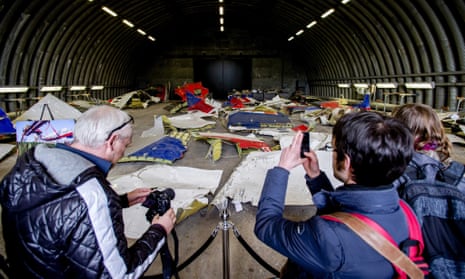The father of a British man killed when Malaysia Airlines flight MH17 came down over eastern Ukraine has said he hopes an official report into the crash, to be released later on Tuesday, will conclude that all of the passengers were killed as soon as the plane was hit.
Barry Sweeney’s son, Liam, was one of 298 on board the flight from Amsterdam to Kuala Lumpur when it crashed on 17 July last year. He was en route to watch Newcastle United play in a pre-season football tour in New Zealand.
The Dutch Safety Board (DSB) is publishing the findings of its 15-month investigation into how the plane came down over a war zone at a time of fierce fighting between pro-Russia separatists backed by Moscow and Ukrainian government troops.
Sweeney said: “I think what we are going to hear is that the plane was blown out of the sky, and hopefully everybody died instantly.”
The DSB will provide a technical account of how the plane came down near Grabovo in eastern Ukraine, but it will not deal with “blame and culpability”.
A second criminal investigation by the Dutch prosecutor’s office is due to conclude later this year or early in 2016. It is expected to answer the most politically charged question of who shot down MH17.
Tuesday’s report is expected to indicate whether some passengers survived the initial impact of a missile strike, after the body of one passenger was found with an oxygen mask around his neck.
Sweeney said he hoped none of the passengers survived the initial impact. Speaking to BBC Radio 4’s Today programme, he said: “I think once the missile hit the plane the decompression [would have meant] people were unconscious or dead within seconds. It’s a hard situation to comprehend.”
He said he was not frustrated by the length of the inquiry, which has been dogged by problems of investigators gaining access to the crash site. “It’s been a long time but I think the Dutch have had to be very meticulous – it is not something that they could do straight away,” Sweeney said.
The report is also expected to provide answers as to why the Dutch authorities took up to four days to inform relatives of the death of passengers. Sweeney said he found out about Liam’s death on a Newcastle United fan site, a day after the crash.
He said: “I basically found out on social media the next morning. I wasn’t sure what flight Liam was on – he just said he was going to New Zealand to watch Newcastle United and that was it. I got in touch with emergency lines and I wasn’t getting anything back. I found out on NUFC.com.”
Contributors to the forum wrongly assumed that the Sweeneys knew of their son’s death at the time.
Two-thirds of those on board were Dutch. The remaining passengers were from nine other countries, including 10 from Britain.
It is widely assumed that Russia-backed separatists were responsible for bringing down MH17, but the US has stopped short of blaming Moscow directly. The Kremlin, meanwhile, has blamed Kiev. It has variously suggested a Ukrainian military jet shot down the Boeing, or that a missile was launched from a government-held area.
In Moscow, the makers of Buk missile systems, Almaz-Antey, gave a press conference on Tuesday morning apparently aimed at distracting attention from the Dutch report.
The manufacturer said it had performed two experiments which it says proves one of its missiles could not have been launched from areas under pro-Russian separatist control.
Representatives of the defence concern said they had used the carcass of a decommissioned Ilyushin-86 aircraft, similar in shape to a Boeing 777, as they did not have any decommissioned Boeings, and showed video of ground-based experiments in which Buk missiles were fired at the front section of the plane.
The press conference was held in a huge hall, and attended by journalists from around the world, some of whom had been flown in at the expense of the organisers to cover the event.
The company’s technical director gave a long presentation packed with graphs and data which he claimed backed up the Russian manufacturer’s results, but did not address why so much eyewitness evidence put the Buk missile system inside separatist territory.
